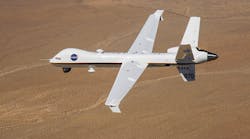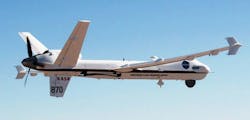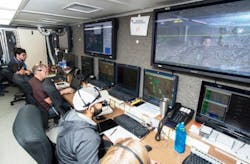Unmanned NASA Aircraft Flies in Public Airspace Without a Chase Plane
NASA is pursuing a program that integrates unmanned aircraft systems (UAS) into the National Airspace System, or UAS-NAS. This involves identifying, developing, and testing the technologies and procedures that will make it possible for UAS to have routine access to airspace occupied by human-piloted aircraft.
Four NASA centers support the UAS-NAS project: NASA’s Ames Research Center and Armstrong Flight Research Center in California, Langley Research Center in Virginia, and Glenn Research Center in Ohio.
The UAS-NAS project is within the Integrated Aviation Systems Research Program, managed by NASA’s Aeronautics Research Mission Directorate at NASA Headquarters in Washington, D.C.
The project uses modeling, simulations, and flight tests to develop and test technologies that provide safe, effective, secure capabilities including detect and avoid (DAA) and command and control (C2).
Initial Run
In June 2018, NASA’s remotely piloted Ikhana aircraft, based at the agency’s Armstrong Flight Research Center in Edwards, Calif., successfully flew its first mission in the National Airspace System without a safety chase aircraft (Fig. 1). This historic flight moves the United States one step closer to normalizing unmanned aircraft operations in the airspace used by commercial and private pilots (see below for details on the first successful trans-Atlantic remotely piloted aircraft).
1. NASA’s Ikhana aircraft could be the first large unmanned aircraft system to fly in the National Airspace System without the requirement of an escort aircraft, outside of Class A and Special Use Airspace. (Credit: NASA Photo/Carla Thomas)
Flying these large, remotely piloted aircraft over the United States opens the doors to all types of services, from monitoring and fighting forest fires, to providing new emergency search and rescue operations. The technology in this aircraft could, at some point, be scaled down for use in other general aviation aircraft. Figure 2 shows the mission-control room for the Ikhana flight.
“This is a huge milestone for our Unmanned Aircraft Systems Integration in the National Airspace System project team,” says Ed Waggoner, NASA’s Integrated Aviation Systems Program director. “We worked closely with our Federal Aviation Administration colleagues for several months to ensure we met all their requirements to make this initial flight happen.”
Flights of large aircraft like Ikhana, have traditionally required a safety chase aircraft to follow the unmanned aircraft as it travels through the same airspace used by commercial aircraft. The Ikhana flew in accordance with the Federal Aviation Administration’s (FAA) Technical Standard Order 211—Detect and Avoid Systems—and Technical Standard Order 212—Air-to-Air Radar for Traffic Surveillance.
The FAA granted NASA special permission to conduct this flight under the authority of a Certificate of Waiver or Authorization on March 30. The certificate permitted Ikhana’s pilot to rely on the latest Detect and Avoid technology, enabling the remote pilot on the ground to see and avoid other aircraft during the flight.
2. Engineers at NASA’s Armstrong Flight Research Center monitor the remotely piloted Ikhana aircraft from a mission-control room during a test flight on June 12, 2018. (Credit: NASA/Ken Ulbrich)
NASA successfully worked with its industry partners to develop a standard for Detect and Avoid technologies, complied with the requirements of the FAA Technical Standard Orders, and garnered flight approval from the FAA.
Detect and Avoid
General Atomics Aeronautical Systems Inc.’s (GA‑ASI) Detect and Avoid (DAA) avionics system played a key role that enabled an unmanned aircraft flight through the National Airspace System (NAS). The DAA system installed on Ikhana, a NASA-owned Predator B/MQ-9 UAS, enabled the UAS to meet the FAA’s 14 CFR 91.113(b) requirement to “see and avoid” other aircraft during the flight.
The DAA system combines automatic collision avoidance with the ability for the pilot to remain ‘well clear’ of other airspace users. Its subsystems include a GA-ASI-developed airborne radar, a TCAS II and DAA tracking capability from Honeywell, Automatic Dependent Surveillance-Broadcast (ADS-B) IN/OUT, and a Conflict Prediction and Display System.
“Our DAA system is more capable than the collision-avoidance systems required on today’s commercial manned aircraft and we believe it far exceeds the average pilot’s ability to ‘see and avoid’,” says David R. Alexander, president, Aircraft Systems, GA-ASI. “The predictive capabilities our system employs create a safe environment for manned and unmanned aircraft to fly together in the NAS.”
GA-ASI has been working with the FAA, NASA’s Armstrong Flight Research Center, Honeywell, and other industry partners since 2013 to develop, flight test, and standardize an airborne DAA system. Flight tests on NASA’s Ikhana served as the basis for verification and validation of RTCA DO-365 and DO-366 technical standards for DAA, which were published by RTCA in May 2017.
GA-ASI has been developing the DAA system with internal funding for inclusion on all its aircraft. In particular, the new MQ-9B SkyGuardian is provisioned to include the DAA system as a customer option. The company’s MQ-25 offering also includes the opportunity for the U.S. Navy to incorporate DAA. The DAA system for MQ-9B is designed to comply with the FAA-designated DO-365, “Minimum Operational Performance Standards for Detect and Avoid Systems.”
Flight Plans
The flight took off from Edwards Air Force Base in California (outside of Los Angeles) and entered controlled air space almost immediately. Ikhana flew into the Class-A airspace, where commercial airliners fly, just west of Edwards at an altitude of about 20,000 feet. The aircraft then turned north toward Fresno, requiring air traffic control to be transferred from the Los Angeles Air Route Traffic Control Center to the Oakland Air Route Traffic Control Center. On the return trip, the pilot headed south toward Victorville, Calif., requiring communication control to be transferred back to Los Angeles.
During the return flight, the pilot began a gentle descent over the city of Tehachapi, Calif., into Class E airspace—about 10,000 feet—where general aviation pilots fly. The pilot initiated an approach into Victorville airport at 5,000 feet, coordinating in real time with air traffic controllers at the airport. After successfully executing all of these milestones, the aircraft exited the public airspace and returned to its base at Armstrong.
“We are flying with a suite of sophisticated technology that greatly enhances the safety capabilities of pilots flying large unmanned aircraft in the National Airspace System,” says Scott Howe, Armstrong test pilot. “We took the time to mitigate the risks and to ensure that we, as a program, were prepared for this flight.”
Future
While NASA’s Ikhana aircraft has been used as a key research UAS, future flight series will use NASA’s Sensor Integrated Environmental Remote Research Aircraft, or SIERRA-B. Originally developed by Ames, the medium-sized UAS meets flight test requirements, including its large nose bay and payload area, which will house the airborne surveillance sensor and other DAA flight test equipment.
A key test team challenge with the SIERRA-B is its smaller size, which makes it more difficult for pilots to see the aircraft at safe distances during air-to-air encounters. The SIERRA-B has a 20-foot wingspan and weighs about 500 pounds compared to the approximately 8,000-pound Ikhana with a 66-foot wingspan. These flight tests will evaluate how DAA standards developed for larger, faster UAS will need to be adapted for smaller and slower aircraft, and thus expand NAS access to a larger group of UAS.
GA-ASI SkyGuardian Completes First Trans-Atlantic Flight of a MALE RPA
Another milestone was reached on July 10, 2018 when a medium-altitude, long-endurance (MALE) remotely piloted aircraft (RPA), produced by General Atomics Aeronautical Systems (GA-ASI), landed at the Royal Air Force (RAF) Fairford in Gloucestershire, UK: It became the first MALE RPA to successfully complete a trans-Atlantic flight. The MQ-9B SkyGuardian, which took off from Grand Forks, N.D., USA, covered 3,760 nautical miles in 24 hours 2 minutes.
MQ-9B is the next generation of GA-ASI’s multi-mission Predator B fleet. The company named its baseline MQ-9B aircraft SkyGuardian, and the maritime surveillance variant SeaGuardian. MQ-9B is a “type-certifiable” (STANAG 4671-compliant) version of the MQ-9 Predator B product line.
Its development is the result of a five-year, company-funded effort to deliver a RPA that can meet the stringent airworthiness type-certification requirements of various military and civil authorities, including the UK Military Airworthiness Authority (MAA) and the U.S. FAA. Type-certification, together with an extensively tested collision-avoidance system, will allow unrestricted operations in all classes of civil airspace.



